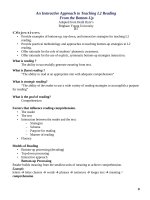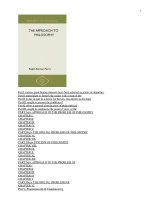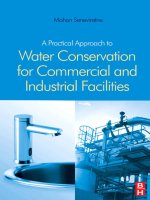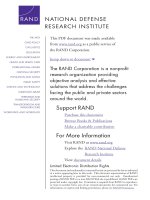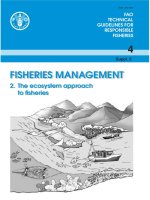Recommended Approach to Software Development Revision 3
Bạn đang xem bản rút gọn của tài liệu. Xem và tải ngay bản đầy đủ của tài liệu tại đây (1.89 MB, 213 trang )
SOFTWARE ENGINEERING LABORATORY SERIES
Recommended Approach to
Software Development
Revision 3
JUNE 1992
National Aeronautics and
Space Administration
Goddard Space Flight Center
Greenbelt, Maryland 20771
SEL-81-305
FOREWORD
The Software Engineering Laboratory (SEL) is an organization sponsored by the
National Aeronautics and Space Administration/Goddard Space Flight Center
(NASA/GSFC) and created to investigate the effectiveness of software engineering
technologies when applied to the development of applications software. The SEL was
created in 1976 and has three primary organizational members:
NASA/GSFC, Software Engineering Branch
University of Maryland, Department of Computer Science
Computer Sciences Corporation, Software Engineering Operation
The goals of the SEL are (1) to understand the software development process in the GSFC
environment; (2) to measure the effects of various methodologies, tools, and models on
this process; and (3) to identify and then to apply successful development practices. The
activities, findings, and recommendations of the SEL are recorded in the Software
Engineering Laboratory Series, a continuing series of reports that includes this document.
The previous version of the Recommended Approach to Software Development was
published in April 1983. This new edition contains updated material and constitutes a
major revision to the 1983 version. The following are primary contributors to the current
edition:
Linda Landis, Computer Sciences Corporation
Sharon Waligora, Computer Sciences Corporation
Frank McGarry, Goddard Space Flight Center
Rose Pajerski, Goddard Space Flight Center
Mike Stark, Goddard Space Flight Center
Kevin Orlin Johnson, Computer Sciences Corporation
Donna Cover, Computer Sciences Corporation
Single copies of this document can be obtained by writing to
Software Engineering Branch
Code 552
Goddard Space Flight Center
Greenbelt, Maryland 20771
iii
iv
ACKNOWLEDGMENTS
In preparation for the publication of this document and the Manager's Handbook for
Software Development, teams of technical managers from NASA/GSFC and Computer
Sciences Corporation (CSC) met weekly for many months to resolve issues related to flight
dynamics software development. It was through their efforts, experience, and ideas that
this edition was made possible.
NASA/GSFC Team Members
Sally Godfrey
Scott Green
Charlie Newman
Rose Pajerski
Mike Stark
Jon Valett
CSC Team Members
Linda Esker
Jean Liu
Bailey Spence
Sharon Waligora
Linda Landis
iv
ABSTRACT
This document presents guidelines for an organized, disciplined approach to software
development that is based on studies conducted by the Software Engineering Laboratory
(SEL) since 1976. It describes methods and practices for each phase of a software
development life cycle that starts with requirements definition and ends with acceptance
testing. For each defined life cycle phase, this document presents guidelines for the
development process and its management, and for the products produced and their reviews.
This document is a major revision of SEL-81-205.
NOTE: The material presented in this document is consistent with major NASA/GSFC standards.
v
NOTE:
The names of some commercially available products cited in this document may be copyrighted or
registered as trademarks. No citation in excess of fair use, express or implied, is made in this document
and none should be construed.
vi
CONTENTS
Section 1 — Introduction..........................................................................1
Section 2 — The Software Development Life Cycle...........................................5
Section 3 — The Requirements Definition Phase ............................................ 21
Section 4 — The Requirements Analysis Phase.............................................. 41
Section 5 — The Preliminary Design Phase .................................................. 63
Section 6 — The Detailed Design Phase.......................................................
85
Section 7 — The Implementation Phase......................................................107
Section 8 — The System Testing Phase......................................................135
Section 9 — The Acceptance Testing Phase .................................................161
Section 10 — Keys to Success..................................................................179
Acronyms...........................................................................................185
References ..........................................................................................187
Standard Bibliography of SEL Literature.......................................................189
Index ................................................................................................201
vii
LIST OF FIGURES
Figure
1-1
2-1
2-2
2-3
3-1
3-2
3-3
3-4
3-5
3-6
3-7
3-8
4-1
4-2
4-3
4-4
4-5
4-6
4-7
5-1
5-2
5-3
5-4
5-5
5-6
5-7
6-1
6-2
6-3
6-4
6-5
6-6
6-7
7-1
7-2
Page
The SEL Software Engineering Environment
Activities by Percentage of Total Development Staff Effort
Reuse Activities Within the Life Cycle
Graph Showing in Which Life-Cycle Phases Each Measure
Is Collected
Generating the System and Operations Concept
Developing Requirements and Specifications
SOC Document Contents
Requirements and Specifications Document Contents
SCR Format
SCR Hardcopy Material Contents
SRR Format
SRR Hardcopy Material Contents
Analyzing Requirements
Timeline of Key Activities in the Requirements Analysis Phase
Effort Data Example - ERBS AGSS
Requirements Analysis Report Contents
SDMP Contents (2 parts)
SSR Format
SSR Hardcopy Material
Developing the Preliminary Design
Preliminary Design Phase Timeline
Extent of the Design Produced for FORTRAN Systems
During the Preliminary and Detailed Design Phases
Level of Detail Produced for Ada Systems During
Preliminary Design
Preliminary Design Report Contents
PDR Format
PDR Hardcopy Material
Generating the Detailed Design
Timeline of Key Activities in the Detailed Design Phase
Checklist for a Unit Design Inspection
Example of the Impact of Requirements Changes
on Size Estimates - the UARS Attitude Ground
Support System
Detailed Design Document Contents
CDR Format
CDR Hardcopy Material
Implementing a Software Build
Phases of the Life Cycle Are Repeated for
Multiple Builds and Releases
viii
1
6
16
19
23
24
33
34
35
36
37
38
43
46
53
55
56
59
60
65
67
72
73
81
82
83
87
88
94
98
100
103
104
109
110
LIST OF FIGURES (cont.)
Figure
Page
7-3 Timeline of Key Activities in the Implementation Phase
7-4 Sample Checklist for Code Inspection
7-5 Integration Testing Techniques
7-6 Development Profile Example
7-7 Example of CPU Usage - ERBS AGSS
7-8 Generalized Test Plan Format and Contents
7-9 BDR Format
7-10 BDR Materials
8-1 System Testing
8-2 Timeline of Key Activities in the System Testing Phase
8-3 Sample Software Failure Report Form
8-4 EUVEDSIM System Test Profile
8-5 SEL Discrepancy Status Model
8-6 User's Guide Contents
8-7 System Description Contents
8-8 ATRR Format
8-8 ATRR Materials
9-1 Acceptance Testing
9-2 Timeline of Key Activities in the Acceptance Testing Phase
9-3 Sample Error-Rate Profile, UARS AGSS
9-4 Software Development History Contents
112
118
121
126
128
131
133
134
136
138
148
152
152
154
156
158
158
163
164
175
178
LIST OF TABLES
Table
2-1
3-1
4-1
5-1
6-1
7-1
8-1
9-1
Measures
Objective
Objective
Objective
Objective
Objective
Objective
Objective
Page
Recommended by the SEL
Measures Collected During the Requirements Definition Phase
Measures Collected During the Requirements Analysis Phase
Measures Collected During the Preliminary Design Phase
Measures Collected During the Detailed Design Phase
Measures Collected During the Implementation Phase
Measures Collected During the System Testing Phase
Measures Collected During the Acceptance Testing Phase
ix
18
31
51
78
97
125
151
174
x
Section
1
-
Introduction
SECTION 1
INTRODUCTION
This document presents a set of guidelines that constitute a disciplined approach to software
development. It is intended primarily for managers of software development efforts and
for the technical personnel (software engineers, analysts, and programmers) who are
responsible for implementing the recommended procedures. This document is neither a
manual on applying the technologies described here nor a tutorial on monitoring a government contract. Instead, it describes the methodologies and tools that the Software
Engineering Laboratory (SEL) recommends for use in each life cycle phase to produce
manageable, reliable, cost-effective software.
THE FLIGHT DYNAMICS ENVIRONMENT
The guidelines included here are those that have proved effective in the experiences of the
SEL (Reference 1). The SEL monitors and studies software developed in support of flight
dynamics applications at the National Aeronautics and Space Administration/Goddard
Space Flight Center (NASA/GSFC). Since its formation in 1976, the SEL has collected
data from more than 100 software development projects. Typical projects range in size
from approximately 35,000 to 300,000 delivered source lines of code (SLOC) and require
from 3 to 60 staff-years to produce.
Flight dynamics software is developed in two distinct computing environments: the Flight
Dynamics Facility (FDF) and the Systems Technology Laboratory (STL). (See Figure
1-1.) Mission support software is engineered and operated in the mainframe environment
of the FDF. This software is used in orbit determination, orbit adjustment, attitude determination, maneuver planning, and general mission analysis. Advanced concepts for flight
dynamics are developed and studied in the STL. Software systems produced in this facility
include simulators, systems requiring special architectures (e.g., embedded systems), flight
SYSTEMS DEVELOPMENT
FLIGHT DYNAMICS
FACILITY
• MISSION SUPPORT
SOFTWARE
FLIGHT DYNAMICS
MISSION SUPPORT
REQUIREMENTS
SYSTEMS TECHNOLOGY
LABORATORY
• ADVANCED SYSTEMS
FUTURE
NEEDS
• DEVELOPMENT AND
MAINTENANCE OF
OPERATIONAL SYSTEMS
• MISSION ANALYSIS AND
OPERATIONS
• RESEARCH AND
DEVELOPMENT
• NEW TOOLS, METHODS,
LANGUAGES
ADVANCED
TECHNOLOGY
• EXTENSIVE TOOLSETS
FOR DEVELOPMENT
• STABLE/UNCHANGING
HARDWARE
• SEL DATABASE
PROVEN
TECHNOLOGY
Figure 1-1.
The SEL Software Engineering Environment
1
Section
1
-
Introduction
dynamics utilities, and projects supporting advanced system studies.
The STL also hosts the SEL database and the entire set of SEL
research tools.
This revised edition of the Recommended Approach to Software
Development reflects the evolution in life cycle, development
methodology, and tools that has taken place in these environments in
recent years. During this time, Ada and object-oriented design
(OOD) methodologies have been introduced and used successfully.
The potential for reuse of requirements, architectures, software, and
documentation has been, and continues to be, studied and exploited.
Ongoing studies also include experiments with the Cleanroom
methodology (References 2 through 4), formal inspection, and
computer-aided software engineering (CASE) tools.
Because the SEL's focus is process improvement, it is a catalyst for
this evolution. The SEL continuously conducts experiments using
the actual, production environment. The lessons learned from these
experiments are routinely fed back into an evolving set of standards
and practices that includes the Recommended Approach.
As these studies are confined to flight dynamics applications,
readers of this document are cautioned that the guidance presented
here may not always be appropriate for environments with
significantly different characteristics.
DOCUMENT OVERVIEW
This document comprises 10 sections. Sections 3 through 9 parallel
the phases of the software development life cycle through acceptance
testing, and discuss the key activities, products, reviews,
methodologies, tools, and metrics of each phase.
Section 1 presents the purpose, organization, and intended
audience for the document.
Section 2 provides an overview of the software development
life cycle. The general goals of any software development effort
are discussed, as is the necessity of tailoring the life cycle to adjust
to projects of varying size and complexity.
Section 3 provides guidelines for the requirements definition
phase. Generation of the system and operations concept and the
requirements and specifications documents are covered. The
purpose and format of the system concept and requirements reviews
are outlined.
2
Section
1
-
Introduction
Section 4 discusses the key activities and products of the
requirements analysis phase: requirements classifications,
walk-throughs, functional or object-oriented analysis, the
requirements analysis report, and the software specifications review.
Section 5 presents the recommended approach to preliminary
design. The activities, products, and methodologies covered
include structured and object-oriented design, reuse analysis, design
walk-throughs, generation of prolog and program design language,
the preliminary design report, and the preliminary design review.
Section 6 provides comparable material for the detailed design
phase. Additional topics include the build test plan, completion of
prototyping activities, the critical design review, and the detailed
design document.
Section 7 contains guidelines for implementation of the
designed software system. Coding, code reading, unit testing, and
integration are among the activities discussed. The system test plan
and user's guide are summarized.
Section 8 addresses system testing, including test plans, testing
methodologies, and regression testing. Also covered are preparation
of the system description document and finalization of the
acceptance test plan.
Section 9 discusses the products and activities of the acceptance
testing phase: preparing tests, executing tests, evaluating results,
and resolving discrepancies.
Section 10 itemizes key DOs and DON'Ts for project success.
A list of a c r o n y m s , r e f e r e n c e s , a
bibliography of SEL literature, and an
index conclude this document.
REFERENCE
Recent SEL papers on software
maintenance include
"Measurement Based
Improvement of Maintenance i n
the SEL," and "Towards Full
Life Cycle Control, " both by
Rombach, Ulery, and Valett.
See References 5 and 6.
Although the m a i n t e n a n c e
and
operation phase is beyond the scope of
the current document, efforts are now
underway in the SEL to study this important
part of the life cycle. The results of these
studies will be incorporated into a future
edition.
3
Section
4
1
-
Introduction
Section 2 - Life Cycle
SECTION 2
THE SOFTWARE DEVELOPMENT LIFE CYCLE
The flight dynamics software development process is modeled as a series of
eight sequential phases, collectively referred to as the software development
life cycle:
1. Requirements Definition
2. Requirements Analysis
3. Preliminary Design
4. Detailed Design
5. Implementation
6. System Testing
7. Acceptance Testing
8. Maintenance & Operation
Each phase of the software development life cycle is characterized by
specific activities and the products produced by those activities.
As shown in Figure 2-1, these eight phases divide the software life cycle
into consecutive time periods that do not overlap. However, the activities
characteristic of one phase may be performed in other phases. Figure 2-1
graphs the spread of activities throughout the development life cycle of
typical flight dynamics systems. The figure shows, for example, that
although most of the work in analyzing requirements occurs during the
requirements analysis phase, some of that activity continues at lower levels
in later phases as requirements evolve.
1
Section 2 - Life Cycle
PERCENTAGE OF TOTAL STAFF EFFORT
ACCEPTANCE
TESTING
SYSTEM TESTING
IMPLEMENTATION
DESIGN
REQUIREMENTS ANALYSIS
REQUIREMENTS
DEFINITION
PHASE
DETAILED
DESIGN
PHASE
PRELIMINARY
DESIGN PHASE
REQUIREMENTS
ANALYSIS PHASE
IMPLEMENTATION PHASE
SYSTEM
TEST
PHASE
ACCEPTANCE
TEST PHASE
MAINTENANCE AND
OPERATION PHASE
CALENDAR TIME
Example: At the end of the implementation phase (5th dashed line), approximately 46% of the staff are involved in system testing;
approximately 15% are preparing for acceptance testing; approximately 7% are addressing requirements changes or problems;
approximately 12% are designing modifications; and approximately 20% are coding, code reading, unit testing, and integrating
changes. Data are shown only for the phases of the software life cycle for which the SEL has a representative sample.
Figure 2-1. Activities by Percentage of Total Development Staff Effort
PHASES OF THE LIFE CYCLE
The eight phases of the software development life cycle are defined in the following
paragraphs.
Requirements Definition
Requirements definition is the process by which the needs of the customer are translated
into a clear, detailed specification of what the system must do. For flight dynamics
applications, the requirements definition phase begins as soon as the mission task is
established. A team of analysts studies the available information about the mission and
develops an operations concept. This includes a timeline for mission events, required
attitude maneuvers, the types of computational processes involved, and specific operational
scenarios. The functions that the system must perform are defined down to the level of a
subsystem (e.g., a telemetry processor).
2
Section 2 - Life Cycle
NOTE
In this document, the term analyst refers
to those specialists in flight dynamics
(astronomers, mathematicians, physicists,
and engineers) who determine the detailed
requirements of the system and perform
acceptance tests. For these activities,
analysts work in teams (e.g., the
requirements definition team) and function
as agents for the end users of the system.
NOTE
In each phase of the life
cycle, certain milestones
must be reached in order to
declare the phase complete.
FINISH
Because the life cycle is
sequential, these exit criteria are also the
entry criteria for the following phase. In
this document, entry and exit criteria are
shown in the summary tables on the first
page of Sections 3 through 9. A brief
discussion of the phase's exit criteria is
provided at the conclusion of each section.
Working with experienced developers, analysts
identify any previously developed software that can
be reused on the current project. The advantages
and disadvantages of incorporating the existing
components are weighed, and an overall
architectural concept is negotiated. The results of
these analyses are recorded in the system and
operations concept (SOC) document and assessed in
the system concept review (SCR).
Guided by the SOC, a requirements definition team
derives a set of system-level requirements from
documents provided by the mission project office.
A draft version of the requirements is then recast in
terms suitable for software design. These
specifications define what data will flow into the
system, what data will flow out, and what steps
must be taken to transform input to output.
Supporting mathematical information is included,
and the completed requirements and specifications
document is published. The conclusion of this
phase is marked by the system requirements review
( S R R ) , during which the requirements and
specifications for the system are evaluated.
Requirements Analysis
The requirements analysis phase begins after the SRR. In this
phase, the development team analyzes the requirements and
specifications document for completeness and feasibility. The
development team uses structured or object-oriented analysis and a
requirements classification methodology to clarify and amplify the
document. Developers work closely with the requirements
definition team to resolve ambiguities, discrepancies, and to-bedetermined (TBD) requirements or specifications.
The theme of reuse plays a prominent role throughout the
requirements analysis and design phases. Special emphasis is
placed on identifying potentially reusable architectures, designs,
code, and approaches. (An overview of reuse in the life cycle is
presented later in this section.)
When requirements analysis is complete, the development team
prepares a summary requirements analysis report as a basis for
preliminary design. The phase is concluded with a software
specifications review (SSR), during which the development team
presents the results of their analysis for evaluation. The
3
Section 2 - Life Cycle
requirements definition team then updates the requirements and
specifications document to incorporate any necessary modifications.
Preliminary Design
The baselined requirements and specifications form a contract
between the requirements definition team and the development team
and are the starting point for preliminary design. During this phase,
members of the development team define the software architecture
that will meet the system specifications. They organize the
requirements into major subsystems and select an optimum design
from among possible alternatives. All internal and external
interfaces are defined to the subsystem level, and the designs of
high-level functions/objects are specified.
The development team documents the high-level design of the
system in the preliminary design report. The preliminary design
phase culminates in the preliminary design review (PDR), where the
development team formally presents the design for evaluation.
Detailed Design
During the detailed design phase, the development team extends the
software architecture defined in preliminary design down to the unit
level. By successive refinement techniques, they elaborate the
preliminary design to produce "code-to" specifications for the
software. All formalisms for the design are produced, including the
following:
•
•
•
•
•
Functional or object-oriented design diagrams
Descriptions of all user input, system output (for example,
screen, printer, and plotter), and input/output files
Operational procedures
Functional and procedural descriptions of each unit
Descriptions of all internal interfaces
among units
The development team documents these
design specifications in the detailed design
d o c u m e n t that forms the basis for
implementation. At the critical design review
(CDR), which concludes this phase, the
detailed design is examined to determine
whether levels of detail and completeness are
sufficient for coding to begin.
4
DEFINITIONS
Throughout this document, the term
unit is used to designate any set of
program statements that are logically
treated as a whole. A main program, a
subroutine, or a subprogram may each
be termed a unit. A module is a
collection of logically related units.
Component is used in its English
language sense to denote any
constituent part.
Section 2 - Life Cycle
Implementation
In the implementation (code, unit testing, and integration) phase, the
developers code new components from the design specifications and
revise existing components to meet new requirements. They
integrate each component into the growing system, and perform unit
and integration testing to ensure that newly added capabilities
function correctly.
In a typical project, developers build several subsystems
simultaneously from individual components. The team repeatedly
tests each subsystem as new components are coded and integrated
into the evolving software. At intervals, they combine subsystem
capabilities into a complete working system for testing end-to-end
processing capabilities. The sequence in which components are
coded and integrated into executable subsystems and the process of
combining these subsystems into systems are defined in an
implementation plan that is prepared by development managers
during the detailed design phase.
The team also produces a system test plan and a draft of the user's
guide in preparation for the system testing phase that follows.
Implementation is considered complete when all code for the system
has been subjected to peer review, tested, and integrated into the
system.
System Testing
During the system testing phase, the development team validates the
completely integrated system by testing end-to-end capabilities
according to the system test plan. The system test plan is based on
the requirements and specifications document. Successfully
completing the tests specified in the test plan demonstrates that the
system satisfies the requirements.
In this phase, the developers correct any errors uncovered by system
tests. They also refine the draft user's guide and produce an initial
system description document. System testing is complete when all
tests specified in the system test plan have been run successfully.
Acceptance Testing
In the acceptance testing phase, the system is tested by an
independent acceptance test team to ensure that the software meets
all requirements. Testing by an independent team (one that does not
have the developers' preconceptions about the functioning of the
system) provides assurance that the system satisfies the intent of the
5
Section 2 - Life Cycle
original requirements. The acceptance test team usually consists of
analysts who will use the system and members of the requirements
definition team.
The tests to be executed are specified in the acceptance test plan
prepared by the acceptance test team before this phase. The plan is
based on the contents of the requirements and specifications
document and approved specification modifications.
During acceptance testing, the development team assists the test team
and may execute acceptance tests under its direction. Any errors
uncovered by the tests are corrected by the development team.
Acceptance testing is considered complete when the tests specified in
the acceptance test plan have been run successfully and the system
has been formally accepted. The development team then delivers
final versions of the software and the system documentation (user's
guide and system description) to the customer.
Maintenance and Operation
At the end of acceptance testing, the system becomes the
responsibility of a maintenance and operation group. The activities
conducted during the maintenance and operation phase are highly
dependent on the type of software involved. For most flight
dynamics software, this phase typically lasts the lifetime of a
spacecraft and involves relatively few changes to the software. For
tools and general mission support software, however, this phase
may be much longer and more active as the software is modified to
respond to changes in the requirements and environment.
The maintenance and operation phase is not
specifically addressed in this document.
However, because enhancements and error
corrections also proceed through a
development life cycle, the recommended
approach described here is, for the most
part, applicable to the maintenance and
operation phase.
The number and
formality of reviews and the amount of
documentation produced during
maintenance and operation vary depending
on the size and complexity of the software
and the extent of the modifications.
6
NOTE
Recent SEL studies have shown that most
of the effort in initial maintenance of flight
dynamics systems is spent in enhancing
the system after launch to satisfy new
requirements for long-term operational
support. Such enhancements are usually
effected without radically altering the
architecture of the system. Errors found
during the maintenance and operation
phase are generally the same type of faults
as are uncovered during development,
although they require more effort to repair.
Section 2 - Life Cycle
TAILORING THE LIFE CYCLE
One of the key characteristics that has shaped the SEL's
recommended approach to software development is the homogeneous nature of the problem domain in the flight dynamics
environment. Most software is designed either for attitude
determination and control for a specific mission, for mission-general
orbit determination and tracking, or for mission planning. These
projects progress through each life cycle phase sequentially,
generating the standard documents and undergoing the normal set of
reviews.
RULE
The software development/
management plan (SDMP) must
describe how the life cycle will be
tailored for a specific project. See
Section 4 for more details.
Certain projects, however, do not fit this mold.
Within the STL, experiments are conducted to
study and improve the development process.
Advanced tools are developed. For these
development efforts — prototypes, expert
systems, database tools, Cleanroom
experiments, etc. — the life cycle and the
methodologies it incorporates often need
adjustment. Tailoring allows variation in the
level of detail and degree of formality of
documentation and reviews, which may be
modified, replaced, or combined in the tailoring
process. Such tailoring provides a more exact
match to unique project requirements and
development products at a lower overall cost to
the project without sacrificing quality.
The following paragraphs outline general guidelines for tailoring the
life cycle for projects of varying size and type. Additional
recommendations may be found throughout this document,
accompanying discussions of specific products, reviews, methods,
and tools.
Builds and Releases
The sizes of typical flight dynamics projects vary considerably.
Simulators range from approximately 30 thousand source lines of
code (KSLOC) to 160 KSLOC. Attitude ground support systems
for specific missions vary between 130 KSLOC and 300 KSLOC,
while large mission-general systems may exceed 1 million SLOC.
The larger the project, the greater the risk of schedule slips,
requirements changes, and acceptance problems. To reduce these
risks, the implementation phase is partitioned into increments
tailored to the size of the project.
7
Section 2 - Life Cycle
Flight dynamics projects with more than 10
KSLOC are implemented in builds. A build is a
portion of a system that satisfies, in part or
completely, an identifiable subset of the
specifications. Specifications met in one build
also are met in all successor builds. The last
build, therefore, is the complete system.
A release is a build that is delivered for
acceptance testing and subsequently released for
operational use. Projects of fewer than 300
KSLOC are usually delivered in a single release,
unless otherwise dictated by scheduling (e.g.,
launch) considerations or by TBD requirements.
Large projects (more than 300 KSLOC) are
generally delivered in multiple releases of 300 to
500 KSLOC each.
NOTE
Reviews are recommended
for each build. The
suggested format and
contents of build design
reviews are provided in
Section 7.
NOTE
Guidelines for tailoring the
development approach (including
reviews, documentation, and testing)
for projects of differing scope and
function are provided throughout this
document. Look for the scissors
symbol in the margin.
Builds within large projects may last up to 6
months. Builds within small projects may be
only 2 to 3 months in duration.
Reviews
Reviews are conducted to ensure that analysts and developers
understand and fulfill customer needs. Because reviews are
designed to assist developers, not to burden them unnecessarily, the
number of reviews held may vary from project to project. For tools
development, the requirements, requirements analysis, and
preliminary design might be reviewed together at PDR. For small
projects spanning just several months, only two reviews may be
applicable — the SRR and CDR. For very large projects, a CDR
could (and should) be held for each major release and/or subsystem
to cover all aspects of the system and to accommodate changing
requirements.
The criteria used to determine whether one or more reviews can be
combined depend on the development process and the life cycle
phase. In the requirements analysis phase, for example, answers to
the following questions would help determine the need for a separate
SSR:
• Are there outstanding analysis issues that need to be
reviewed?
• How much time will there be between the start of
requirements analysis and the beginning of design?
• How stable are the requirements and specifications?
8
Section 2 - Life Cycle
On small projects, technical reviews can be no more formal than a
face-to-face meeting between the key personnel of the project and
the customer technical representative. On typical flight dynamics
projects, however, reviews are formalized and follow specific
formats. Guidelines for these reviews are provided in Sections 3
through 9.
Documentation
On small projects, technical documentation is less formal than on
medium or large projects, and fewer documents are published.
Documents that would normally be produced separately on larger
projects are combined. On a small research project, a single design
document may replace the preliminary design report, detailed design
document, and system description.
Testing and Verification
Independent testing is generally not performed on small-scale, tooldevelopment efforts. Test plans for such projects can be informal.
Although code reading is always performed on even the smallest
project, units are often tested in logically related groups rather than
individually, and inspections are usually conducted in informal, oneon-one sessions.
Configuration Management and Quality Assurance
Configuration management encompasses all of the activities
concerned with controlling the contents of a software system. These
activities include monitoring the status of system components,
preserving the integrity of released and developing versions of a
system, and governing the effects of changes throughout the
system. Quality assurance activities ensure that software
development processes and products conform to established
technical requirements and quality standards.
All software and documentation that are developed for delivery are
generally subject to formal configuration management and quality
assurance controls. Tools developed exclusively for internal use are
exempt, unless the tool is required to generate, run, or test a
deliverable system.
On medium and small projects, configuration control may be
performed by a designated member of the development team — a
practice that is strongly discouraged on a large project. Similarly,
the quality assurance function may be assigned to a team member
with other responsibilities or may be handled by the technical leader.
9
Section 2 - Life Cycle
Prototyping
A prototype is an early experimental model of a system, system
component, or system function that contains enough capabilities for
it to be used to establish or refine requirements or to validate critical
design concepts. In the flight dynamics environment, prototypes are
used to (1) mitigate risks related to new technology (e.g., hardware,
language, design concepts) or (2) resolve requirements issues. In
the latter case, entire projects may be planned as prototyping efforts
that are designed to establish the requirements for a later system.
Unless the end product of the entire project is
a prototype, prototyping activities are usually
completed during the requirements analysis
and design phases. The prototyping activity
has its own, usually informal, life cycle that is
embedded within the early phases of the full
system's life cycle. If any portion of the
prototype is to become part of the final
system, it must be validated through all the
established checkpoints (design reviews, code
reading, unit testing and certification, etc.).
As a rule, such prototyping activities should
require no more than 15 percent of the total
development effort.
For projects in which the end product is a
prototype, however, an iterative life cycle may
be preferable. This is particularly true when a
new user interface is a significant component
of the system. An initial version of the
prototype is designed, implemented, and
demonstrated to the customer, who adds or
revises requirements accordingly. The
prototype is then expanded with additional
builds, and the cycle continues until
completion criteria are met.
RULE
All prototyping activities must be
planned and controlled. The plan
must define the purpose and scope of
the prototyping effort, and must
establish specific completion criteria.
See Section 4 for more details.
WHEN TO PROTOTYPE
As a rule of thumb, use prototyping
whenever
• the project involves new technology,
e.g., new hardware, development
language, or system architecture
• the requirements are not understood
• there are major, unresolved issues
concerning performance, reliability,
or feasibility
• the user interface is critical to system
success or is not clearly understood
Tailoring the life cycle for any type of prototyping requires careful
planning. The more new technology that is to be used on a project,
the greater the prototyping effort. The larger the prototyping effort,
the more formalized must be its planning, development, and
management. The results of even the smallest prototyping effort
must always be documented. Lessons learned from the prototype
are incorporated into plans for subsequent phases and are included
in the project history. See Section 4 for additional guidance on
planning and documenting prototyping activities.
10
Section 2 - Life Cycle
REUSE THROUGHOUT THE LIFE CYCLE
From the beginning to the end of the life cycle, the approach to
software development recommended by the SEL stresses the
principle of reuse. Broadly speaking, the reuse of existing
experience is a key ingredient to progress in any area. Without
reuse, everything must be relearned and re-created. In software
development, reuse eliminates having to "reinvent the wheel" in each
phase of the life cycle, reducing costs and improving both reliability
and productivity.
Planning for reuse maximizes these benefits by allowing the cost of
the learning curve in building the initial system to be amortized over
the span of follow-on projects. Planned reuse is a primary force
behind such recent technologies as object-oriented design and Ada.
KEY REUSE ELEMENTS
Analyze these key elements of a
project for possible reuse:
• requirements characteristics
• software architecture
• software development process
• design architecture or
concepts
• test plans and procedures
• code
• user documentation
• staff
All experience and products of the software
development life cycle — specifications, designs,
documentation, test plans, as well as code — have
potential for reuse. In the flight dynamics
environment, particular benefits have been
obtained by reusing requirements and specifications (i.e., formats, key concepts, and highlevel functionality) and by designing for reuse (see
References 7 through 10).
Figure 2-2 shows how reuse activities fit into the
software development life cycle. The top half of
the figure contains activities that are conducted to
enable future reuse. The lower half shows
activities in which existing software is used in the
system under development. These activities are
outlined in the following paragraphs.
Activities That Enable Future Reuse
domain
analysis
requirements
generalization
Domain analysis is the examination of the application domain of the
development organization to identify common requirements and
functions. It is usually performed during the requirements definition
and analysis phases, but it may also be conducted as a separate
activity unconnected to a particular development effort. Domain
analysis produces a standard, general architecture or model that
incorporates the common functions of a specific application area and
can be tailored to accommodate differences between individual
projects. It enables requirements generalization, i.e., the
preparation of requirements and specifications in such a way that
they cover a selected "family" of projects or missions.
11
